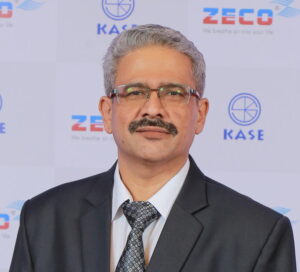The consensus is that India’s HVACR growth narrative can be attributed to rampant infrastructure development, increasing urbanisation, technological advancements, rising disposable incomes and a growing tourism appeal. Indu Revikumar, Features Writer, Climate Control Middle East, has the story
A market report published by P&S Intelligence in November 2022 attributes the growth of the Indian HVACR market, which has a CAGR of 15.8% between 2021 and 2030, to rampant infrastructure development, increasing urbanisation, technological advancements, rising disposable incomes and tourism in the country, says Vikash Sekhani, Director Sales & Marketing, Dry All-India. Elaborating, Sekhani says the increasing urbanisation has led to higher demand for air conditioning and refrigeration systems in residential and commercial buildings, and the rising disposable incomes have enabled more individuals and businesses to invest in HVACR systems for comfort and productivity, contributing to market growth.
The construction sector in India, he says, has been predicted to become the world’s third-largest by 2025, primarily driven by residential construction; this factor will ultimately push the Indian HVACR market to a massive 16% CAGR till 2030. In addition, Sekhani says, HVACR systems are now indispensable in various industries, such as food services, cold storage, data centres, transportation, industrial facilities, pharmaceuticals and sports facilities, where temperature and humidity control is critical for efficient operations.
Weighing in, Milind Mate, AVP (Sales & Marketing), Zeco Aircon Limited, says the shift in the economic growth patterns in India, in the aftermath of the pandemic, had a tremendous impact on the growth of the HVACR industry, as its growth mirrors the expansion of industrial and commercial businesses. Mate says the HVACR industry has been witnessing significant growth in tier-two cities in the last two years, far outnumbering the tier-one cities. Moreover, he says, the tier-two cities are experiencing robust development in commercial construction, including malls, institutions, hospitals, hotels and other commercial facilities. Mate says, “While we’ve seen double-digit growth in recent years, it’s important to acknowledge that this high growth rate is partly due to a rebound from the pandemic’s impact.”

Vikash Sekhani
Highlighting how the pharmaceuticals and the electric vehicle manufacturing sector are contributing to the growth of the HVAC industry, he says their positive growth trajectory, along with progress in semiconductor chip manufacturing, is expected to boost the HVAC industry further. He says that the commercial HVAC industry is poised for higher growth in the next 5-6 years, after which its trajectory may stabilise unless new growth drivers, such as tier-three cities or other industries, emerge.
Joining the conversation, Vikram Murthy, Director, Univac Environment Systems, and Chair, ISHRAE Environment Protection Committee, sharing an overview of the air conditioning market in India, says the key driver for the growth of the air conditioning industry in India is the rise of residential buildings in India’s fastest-growing tier-one and tier-two cities. Air conditioners operating in India in 2022, he says, consumed about 175 Tera Watt Hours (TWH) of energy. That figure, he says, is expected to grow to 600 TWH by 2038, as per the India Cooling Action Plan (ICAP) released by the Ministry of Environment Forests and Climate Change, in 2019. Murthy also points to the fact that rising incomes lead to purchasing electrical appliances and says that in India, once a family’s annual income rises above USD 10,000, they purchase their first air conditioner.
Shifting the discussion to the trends shaping the future of the HVACR industry in India, Jagdeep Singh, Managing Director, Rosemex Ecotech, says a focus on energy efficiency through advanced technologies, like variable-speed compressors and improved insulation; the integration of IoT for smart HVACR systems; the transition to eco-friendly refrigerants for reduced environmental impact; heightened emphasis on Indoor Air Quality and health-related solutions; increased demand from expanding sectors like construction, retail and healthcare; and the growing significance of data centres and green building standards are some of the drivers for the progress of the HVACR market in the country.
 Weighing in, Mate says that in today’s commercial and industrial buildings, there’s a strong focus on sustainability, particularly decarbonisation. Achieving net-zero carbon emissions, he says, is the ultimate goal, although it may be challenging to attain fully. He says there’s a growing emphasis on high-efficiency systems, driven by smart technology and IoT, to work towards this goal. Thus, he adds, there is a push for innovations in components like motors and fans, as fans, in particular, play a crucial role in determining a building’s energy consumption. Furthermore, he says, chillers are also undergoing constant developments to enhance efficiency. Mate also says that manufacturers are regularly introducing new technologies, such as tube axial fans and advanced Variable Frequency Drives (VFDs). He further says that Building Management Systems (BMSes) have evolved from compliance tools to connected systems that collect and leverage data for enhanced efficiency.
Weighing in, Mate says that in today’s commercial and industrial buildings, there’s a strong focus on sustainability, particularly decarbonisation. Achieving net-zero carbon emissions, he says, is the ultimate goal, although it may be challenging to attain fully. He says there’s a growing emphasis on high-efficiency systems, driven by smart technology and IoT, to work towards this goal. Thus, he adds, there is a push for innovations in components like motors and fans, as fans, in particular, play a crucial role in determining a building’s energy consumption. Furthermore, he says, chillers are also undergoing constant developments to enhance efficiency. Mate also says that manufacturers are regularly introducing new technologies, such as tube axial fans and advanced Variable Frequency Drives (VFDs). He further says that Building Management Systems (BMSes) have evolved from compliance tools to connected systems that collect and leverage data for enhanced efficiency.

Vikram Murthy
Giving a broader perspective, Sekhani says the Make in India initiative of the Government has also significantly impacted the HVACR industry in India. The initiative, he says, aims to promote domestic manufacturing and reduce dependence on imports; as a result, several domestic manufacturers have emerged in recent years, offering high-quality HVACR products at competitive prices.
In addition to this, he points out that recently, the Government of India has banned the import of air conditioners with climate-damaging refrigerants and says this move will come as a push for self-reliance and promotion of locally manufactured goods while clamping down on imports from other countries.
Government policies
As in any other country or region, policies are determining the course of the HVACR industry in India. Speaking on how government policies are contributing to the HVACR industry, in general, and green technologies, in particular, Murthy says it is essential to understand the background of the Green Movement in India, since the founding of the Indian Green Building Council (IGBC), in 2000. The IGBC, Murthy says, has reached a significant milestone by registering over one billion square feet of green building area across 1,505 projects. He says various other green rating agencies have also certified hundreds of buildings for their sustainable and environmentally friendly features, underscoring India’s growing emphasis on green and sustainable construction practices and net-zero buildings. To elucidate, he points to the example set by the Ministry of Environment, Forests and Climate Change by establishing its flagship office, Indira Paryavaran Bhavan, in New Delhi, as a net-zero energy installation.
Furthermore, Murthy says, another growth driver behind Green Buildings is the Government Regulated Energy Conservation Building Code (ECBC), released by the Bureau of Energy Efficiency (BEE) in 2007, and updated in 2017. The ECBC, he points out, has been adopted by most Indian State Legislatures. In addition, BEE had set up the Star Labelling of air conditioners as a voluntary programme in 2006 and made it mandatory in 2009. The BEE, for its part, began a voluntary Chiller Labelling Programme in 2019, which will become mandatory in January 2024. The programmes, Murthy says, have created a positive impact for businesses as well as consumers – by creating a meritocracy of products that drive sales for manufacturers and create choices for consumers.

Jagdeep Singh
Weighing in, Sekhani says India is one of the fastest-growing solar markets in the world, and the government target of installing 100 GW of solar power by 2022 created a massive demand for solar panels, inverters and other solar technologies. In addition, he says, the Government of India had set a target of installing 60 GW of wind power by 2022, which has contributed to the growing demand for wind turbines, generators and other wind power technologies in the country.
Furthermore, Sekhani says, the Green Building Rating System, which promotes the development of Green Buildings and energy efficiency initiatives through the National Mission for Enhanced Energy Efficiency (NMEEE); the National Cooling Policy, established in 2020; and the initiatives by Energy Efficiency Services Limited (EESL) are among the key drivers with regard to the increasing popularity of green technologies and energy-efficient HVACR solutions in India. He says: “India now stands fourth globally in Renewable Energy Installed Capacity (including Large Hydro), fourth in wind power capacity and fourth in solar power capacity, as per the REN21 Renewables 2022 Global Status Report. The country had set an enhanced target at the COP26 of 500 GW of non-fossil fuel-based energy by 2030. This has been a key pledge under the Panchamrit, the world’s largest expansion plan in renewable energy.”
For his part, Singh says Government initiatives aimed at the HVACR industry are having several positive impacts on businesses and are creating a favourable environment for market growth. The government initiatives, he says, include the establishment of energy efficiency standards, regulation of environmentally friendly refrigerants, incentives and subsidies for energy-efficient systems, the enforcement of building codes promoting HVACR solutions, smart city programmes, eco-friendly building certifications, and consumer awareness campaigns. These are further driving the demand for energy-efficient HVACR technologies. Additionally, government support for research and development is fostering innovation in the industry.
In India, Mate says, the landscape of policies and regulations regarding energy efficiency has evolved significantly in recent years. The Indian government, he says, has taken the initiative to develop policies and documents relating to energy efficiency and building codes, which are now updated every two to three years. Mate further says that these policies are designed to suit the unique needs of a tropical country like India, and many are on par with – or surpass – international standards. While there isn’t a specific policy exclusively for HVAC initiatives, he adds, compliance with the Energy Conservation Building Code (ECBC) is essential, and it encompasses various regulations and incentives to promote greener and more energy-efficient products and practices. “Moreover, the focus has shifted towards private bodies and organisations in driving these initiatives, with ECBC being a key reference point for compliance,” Mate says.
India’s commercial HVACR market
In India, Sekhani says, the Government is offering several incentives to support the growth of the commercial HVACR market, including tax breaks, grants and loans, under schemes like Mudra Yojana and Start-Up India. These incentives, he says, are helping businesses reduce the cost of installing and operating commercial HVAC systems, making them more affordable and accessible. In addition, factors such as growing population and urbanisation, rising disposable incomes, and increasing awareness of the importance of energy efficiency are also contributing to the growth of the commercial HVAC market in India. Furthermore, Sekhani says, Government campaigns, such as Atithi Devo Bhava and Digital India, are resulting in a high inflow of tourists, thus leading to growth in hospitality and tourism-related businesses and a greater demand for commercial spaces and commercial HVAC systems. The commercial HVAC market in India, he says, is being disrupted by several new technologies, including smart HVAC systems, heat pumps, ventilation with heat recovery, desiccant cooling and geothermal HVAC systems.
Murthy says that disruptive technologies, like advanced cooling methods and super-efficient residential air conditioners, are poised to reshape the commercial HVAC market. “Some of these are controlled single-stage and two-stage evaporative cooling, radiant cooling, District Cooling and super-efficient residential air conditioners,” he says. “The latter, which is also the winner of a Global Cooling prize, is currently under rigorous field testing and shall consume less than half the energy of the most efficient current air conditioners.” Murthy says he believes there is no need for the Government to incentivise the growth of commercial air conditioning projects, as the demand is already increasing, and contracts are typically awarded through competitive tendering or by choosing a preferred Large Build, Operate and Transfer Contractor.
Weighing in, Singh says the commercial HVAC market in India is transforming due to the emergence of various technologies like VRF systems, smart controls, energy recovery ventilation, green refrigerants, integrated BMS, solar HVAC and geothermal solutions. To excel in this market, he says, businesses can adopt strategies such as promoting energy efficiency to align with environmental regulations, customising HVAC systems to individual client needs, offering proactive maintenance services, embracing IoT for smart controls, emphasising sustainability benefits, and leveraging government incentives and subsidies for energy-efficient installations and renewable energy integration.
The Indian export market
The export market for Indian HVACR products is driven by several key factors, such as the growing global demand for cooling solutions due to rising temperatures and urbanisation, and India’s robust manufacturing capabilities, which position it well to meet this demand, Sekhani says. Indian HVACR products, he says, tend to offer competitive pricing, thanks to lower labour and manufacturing costs, and the fact that Indian manufacturers are increasingly adopting high-quality standards, enhances the reputation of their products in international markets.
Furthermore, he says, the Government of India’s strong support through financial assistance, export promotion councils and trade fairs further bolster the sector. “To succeed in exporting HVAC systems, Indian businesses need to comply with international standards like ASHRAE Standard 16, ISO 5149, ARI Standard 1100 and EN 13537, and obtain certifications like CE mark, Underwriters Laboratories (UL) mark, Canadian Standards Association (CSA) mark and Electrical Testing Laboratories (ETL) mark,” Sekhani says. “They can also navigate compliance complexities by working with consultants, training employees and maintaining records. Building relationships with foreign buyers, participating in trade fairs, utilising online platforms and delivering excellent customer service are additional strategies to enhance export success.”
Mate says the export market for HVACR products in India is flourishing due to several key drivers, such as China’s diminished reputation in the wake of the COVID-19 pandemic, which has created opportunities for Indian manufacturers to expand their market presence. He adds that India’s application-focused manufacturing approach, coupled with the adaptability of Indian engineers to international standards, is bolstering its competitiveness. Mate says strong Government support, including incentives and assistance from organisations, like the Federation of Indian Exports, is further strengthening the industry. In addition, he says, Indian HVAC exporters are increasingly targeting emerging markets in Africa, capitalising on the region’s diverse opportunities. “The economic challenges and localised manufacturing have diminished the appeal of European markets,” he says. “The Middle East and North Africa (MENA) region remain pivotal markets for Indian HVAC exporters.”
Adding to the discussion, Murthy says Indian manufacturers of chillers, VRF units, air-handling units and data centre air conditioners are increasingly finding opportunities in the Middle East, Africa and Southeast Asia. This growth, he says, can be attributed to India’s manufacturing capabilities and product quality, which now meet global standards. “In response to the demand in the Indian market, certified products have been long sought after,” Murthy says. “AHRI and
Eurovent are two internationally recognised institutions that have been operating in India for many years, and they provide certifications for various HVAC and refrigeration products, with AHRI certifying various products and Eurovent primarily focusing on air-handling units (AHUs). These certifications ensure that HVAC and refrigeration products meet the standards required by the countries where they are exported, facilitating access to markets that mandate certified product imports.”
For his part, Singh says Indian businesses aiming to navigate the complexities of compliance in the international HVACR market can take several strategic steps. He says these include seeking expert guidance, conducting rigorous testing and certification processes in collaboration with accredited laboratories, maintaining comprehensive documentation of compliance, partnering with experienced export counterparts, and staying well-informed about evolving international standards and regulations. He further says that these measures will collectively facilitate smoother access to global markets and ensure adherence to the necessary product import requirements.
Copyright © 2006-2025 - CPI Industry. All rights reserved.